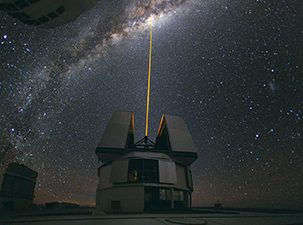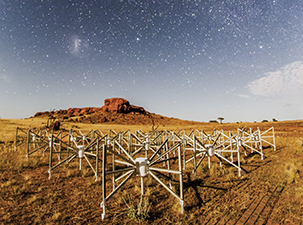Other AAL-supported projects with successes this past year include the Australian Square Kilometre Array Pathfinder (ASKAP). December 2020 was marked by the creation of a new atlas of the Universe, as the Rapid ASKAP Continuum Survey (RACS) conducted its first scan of the entire southern sky in record speed and detail, with approximately three million galaxies mapped in just 300 hours. As part of the project, RACS tested the strength of ASKAP’s technology and computing power, discovering about a million new galaxies along the way.
For more on AAL-supported projects, please visit the “What we do” section of this website.
Industry Engagement
Throughout the 2020-2021 period, AAL has also continued to see the opportunities that exist between astronomy and industry, encouraging engagements by providing funding, support and connections. Overall, AAL’s industry engagement program has grown significantly over the past year, with numerous opportunities created via enhanced communications with astronomers and industry representatives.
The Decadal Plan called for the establishment of “a central body to promote and facilitate industry engagement with the next generation of global facilities”. Whilst AAL is not that central body, it does have a key role supporting its member organisations to develop stronger links with industry. Over the last year AAL has created closer ties between astronomy and industry in order to connect Australian industry with commercial opportunities arising from “Big Science”, provide career paths for astronomy graduates, and support research through the commercial provision of services, facilities and equipment.
AAL created a new website to showcase the capabilities and commercial activities of Australian astronomers. A selection of projects we feature on the site as success stories are listed below:
AAL Operations
Brought on by COVID-19 lockdowns affecting half of the country, AAL staff have spent most of the year working from home. With all the challenges this situation can present, AAL staff have performed incredibly well and have supported each other throughout. With travel restrictions in place for most of the year, the majority of AAL’s interactions have had to take place online. Meetings (internal and external), presentations and other collaborative efforts have all been via videoconference. Interactive platforms designed for remote collaboration have assisted, but the perseverance and hard work of the AAL staff has been the most important factor contributing to a successful year.
Members
AAL is proud that it has member representatives from all institutions in Australia with a significant astronomy research program. In the 2020/21 financial year there were 15 institutional members of AAL. Each member organisation has a nominated representative who attends the Annual General Meeting (AGM) to elect Board Directors. Member representatives are also consulted throughout the year on key astronomy infrastructure and investment decisions. To see a list of AAL representatives, please visit the “Member Institutions” page of this website.
Board
The independent, skills-based AAL Board of Directors comprises seven individuals with expertise in astronomy, management and finance. The board is responsible for the overall governance and strategic direction of AAL. They make key decisions about projects based on the recommendations of advisory committees, their own considerable and diverse expertise, and with consideration of the priorities and recommendations in the Decadal Plan. To see current AAL Board members, please visit the “Board of Directors” page of this website. For a list of AAL Board members current over the 2020/21 period, see the following list:
- Prof. Naomi McClure-Griffiths (Chair)
- Prof. Karl Glazebrook (Deputy Chair)
- Prof. Rachel Webster (Director)
- Dr. Rosalind Dubs (Director)
- Prof. Orsola De Marco (Director)
- Prof. Len Sciacca (Director)
- Dr. Sarah Pearce (Director)
Committees and External Representatives
AAL’s two advisory committees: the Science Advisory Committee (ASAC) and Project Oversight Committee (APOC) – play an important role in ensuring the relevance and quality of AAL’s programs. Committee members are appointed to provide the relevant breadth of expertise, and an appropriate mix of gender, seniority and institutional diversity. AAL’s advisory committees provide strategic advice to the AAL Board in implementing the infrastructure priorities of the Decadal Plan, and support AAL in oversight of, and promoting improved outcomes for, AAL-funded projects. AAL also maintains a number of resource allocation committees, and an Industry Engagement Working Group. For more information, please visit the “AAL Committees” page of this website.
As well as these internally managed groups, AAL appoints astronomers to external boards and committees. AAL then provides support to these appointees to represent the interests of Australian astronomers nationally and internationally. For more information, please visit the “External Representatives” page of this website.
Equity, Diversity and Values
AAL has a long-standing commitment to equity and diversity. AAL’s employment philosophy is open and flexible, with a mix of full and part-time positions, having regard to the work/life balance and individual needs of AAL’s staff. With a responsibility for determining representation on a variety of external bodies related to astronomy, as well as membership of its advisory committees, AAL has a selection process for all these positions that addresses principles of inclusion and gender balance.
In 2021 AAL adopted a new values statement:
AAL endeavours to be an environmentally sustainable organisation built upon equity, diversity and mutual respect for its staff and stakeholders.
This change reflects AAL’s desire to consider the environment in its everyday operations while maintaining our existing emphasis on upholding respectful interactions with all people. For more information, please visit the “Environmental, Social and Governance” page of this website.






